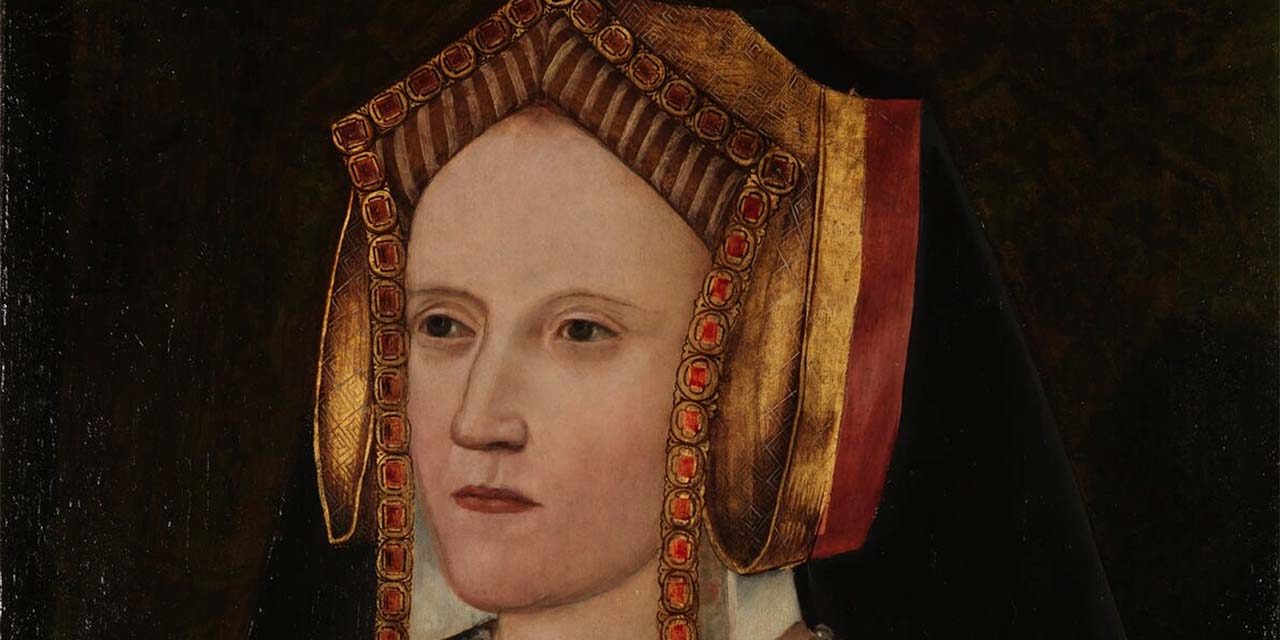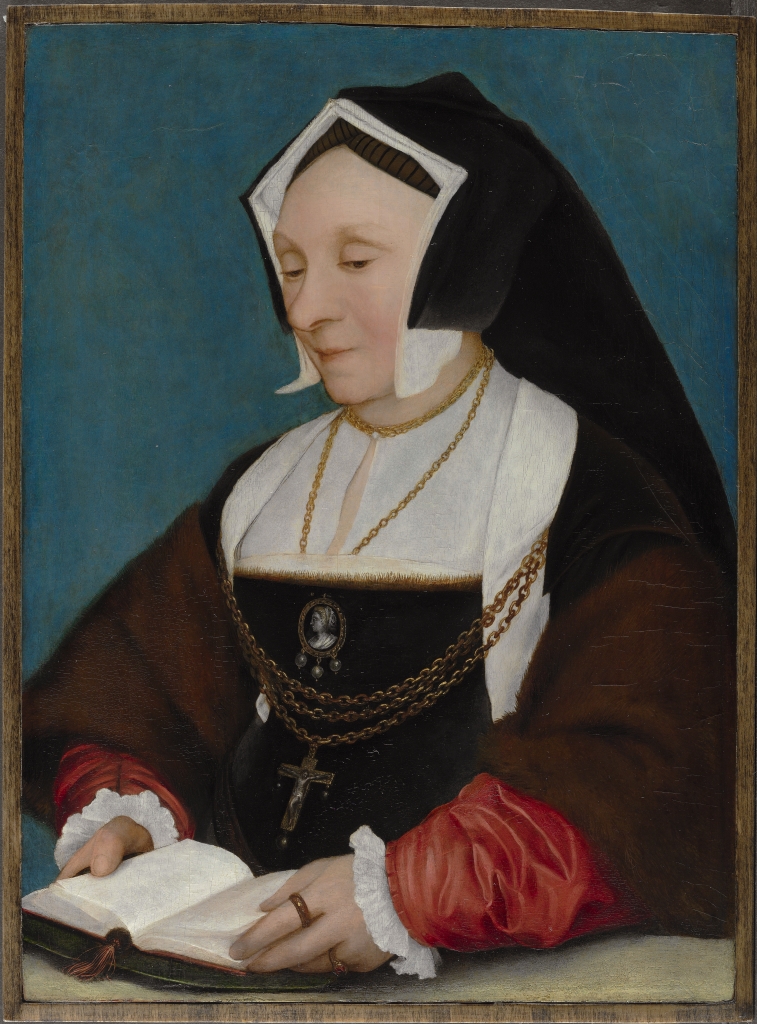The Details
“Woman’s headdress worn from 1500s to 1540s, sometimes made of black fabric wired to form a peak or gable over the forehead with long velvet lappets at side and the back draped in think folds over the shoulders. After 1525, the back drapery became two long pendant flaps.” (682)
The Metropolitan Museum of Art has a portrait of Mary Wotton in a traditional gabled hood (Fig. 1). Queen Katherine of Aragon is featured in a colorful and extravagant gabled hood that matches her dress (Fig. 2).
Daniel Delis Hill in History of World Costume and Fashion (2011) writes:
“England at the start of the century, the gabled hood, sometimes called a pediment headdress, was worn by aristocratic women. It was fashioned from a light wire frame shaped like the gabled roof of a house over which draped velvet. Long lappets of richly embroidered ribbon hung down in front. Some hoods were constructed in sections with alternating light and dark or plain and elaborate fabrics.” (456)
The National Portrait Gallery features another portrait of Katherine of Aragon wearing her gabled hood, along with a darker clothing color palette (Fig. 3).
In the Berg Dictionary of Fashion History, the English hood is defined as:
“A hood wired up to form a pointed arch above the forehead. The early form hung in thick folds to the shoulders behind, with the facial borders continued into long lappets, called chaffers, in front. An under cap was worn, but the smooth, parted hair was visible under the gable until ca. 1525. After that date the back drapery was replaced by two long pendant flaps, sometimes pinned up, and the front lappets were shortened, turned up and pinned in place. The front hair was concealed in silk sheaths, often striped, and crossed over under the gable point.”
The portrait of Lady Alice More (Fig. 4) shows an intimate moment alone reading; unlike the others, More’s gabled hood is much simpler and is only black and white.
A sketch by Hans Holbein of the front and back of a gabled hood (Fig. 5) make it clear as to what it would look like. It is easy to see how the gabled hood is split in the back but comes to a point in the front. Another depiction of Katherine of Aragon displays in intricate soft details the structure of the gabled hood (Fig. 6).
Fig. 1 - Hans Holbein the Younger (Swiss and German, 1497-1543). Mary, Lady Guildford, 1527. Tempera on wood; 87 x 70.6 cm (34 1/4 x 27 13/16 in). St. Louis: Saint Louis Art Museum, 1:1943. Museum Purchase. Source: SLAM
Fig. 2 - Artist unknown. Katherine of Aragon, ca. 1520. Oil on oak panel; 52 x 42 cm (20.5 x 16.5 in). London: National Portrait Gallery, NPG L246. Lent by Church Commissioners for England, 2011. Source: National Portrait Gallery
Fig. 3 - Artist unknown. Katherine of Aragon, early 18th century. Oil on panel; 55.9 x 44.5 cm (22 x 17.5 in). London: National Portrait Gallery, NPG 163. Purchased, 1863. Source: National Portrait Gallery
Fig. 4 - Hans Holbein the Younger (Swiss and German, 1497-1543). Lady Alice More, 1530. Oil on panel; 36.9 x 26.7 cm (14 3/4 x 10 11/16 in). London: The Weiss Gallery. Source: Weiss Gallery
Fig. 5 - Hans Holbein (Swiss and German, 1497-1543). Front and back views of a box-backed gable hood, 1528–1530. Brush drawing in brown ink, tinted with pink and grey wash; on off-white paper; 15.9 x 11 cm. London: British Museum, 1895,0915.991. Source: British Museum
Fig. 6 - Lucas Horenbout (English, 1490/1495–1544). Katherine of Aragon, circa 1525-1526. Watercolour on vellum; 3.9 cm (1 1/2 in). Private Collection, NPG L244. Lent by an anonymous lender, 2009. Source: National Portrait Gallery
Fig. 7 - Karl Lagerfeld for Chanel (German, 1933-). Couture Collection, Fall 2013. Model: Xiao Wen Ju (IMG). Photo: Yannis Vlamos. Source: Vogue
Its Afterlife
References:
- Brown, Susan, ed. Fashion: The Definitive History of Costume and Style. New York: DK Publishing, 2012. http://www.worldcat.org/oclc/840417029.
- Cumming, Valerie, C. Willett Cunnington, Phillis Cunnington, Charles Relly Beard, and C. Willett Cunnington. The Dictionary of Fashion History. Revised. New York: Berg, 2010. http://www.worldcat.org/oclc/751443348.
- “Gable Hood.” Wikipedia, June 10, 2017. https://en.wikipedia.org/w/index.php?title=Gable_hood&oldid=784837100.
- Hill, Daniel Delis. History of World Costume and Fashion. Upper Saddle River, NJ: Pearson Prentice Hall, 2011. http://www.worldcat.org/oclc/768100950.
- Tortora, Phyllis G., Sandra J. Keiser, and Bina Abling. The Fairchild Books Dictionary of Fashion. 4th edition. New York: Fairchild Books, 2014. http://www.worldcat.org/oclc/963869805.

















